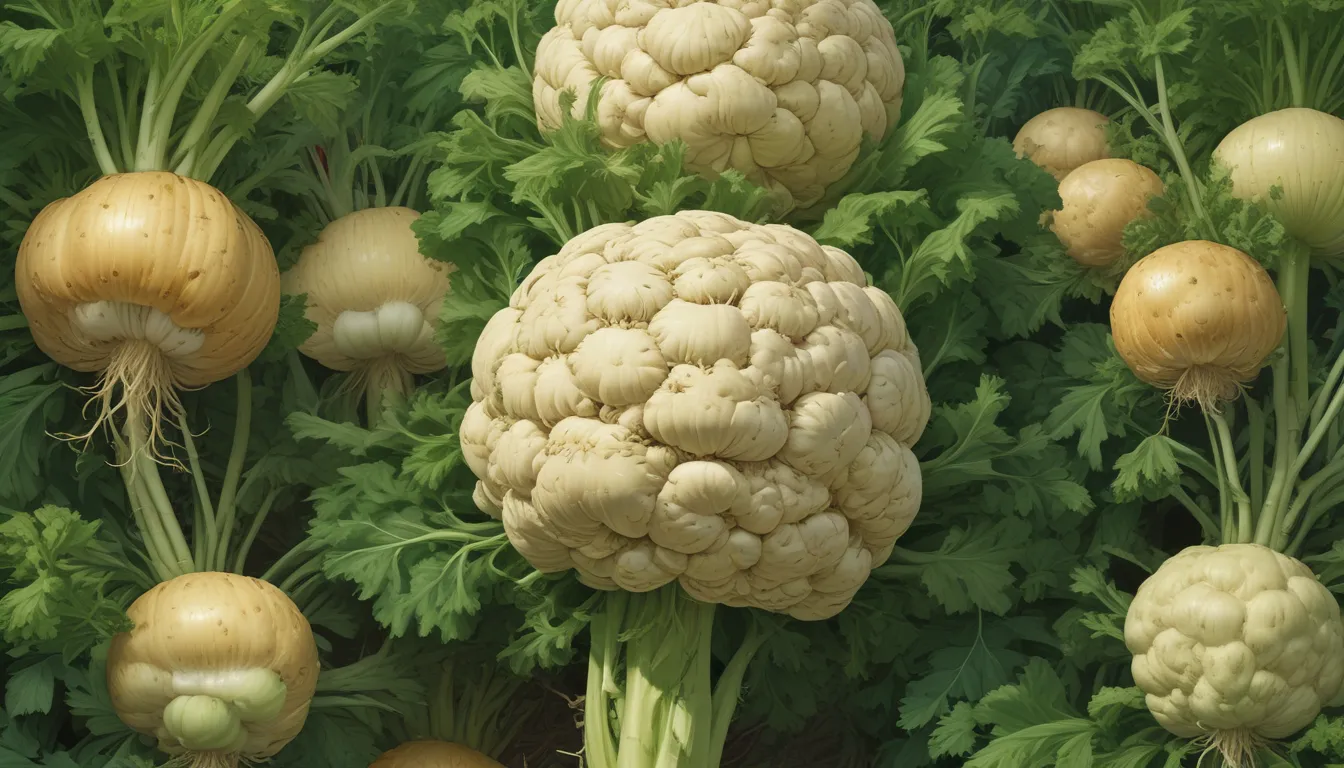Ultimate Guide to Planting and Growing Celery Root (Celeriac)

If you are a fan of both celery and root vegetables, then you will absolutely love the versatile veggie that is celery root, also known as celeriac (Apium graveolens var. rapaceum). This little-known vegetable may not win any beauty contests, but it offers a comforting, earthy flavor with hints of turnip, parsley, and celery, and a consistency that resembles a potato.
Let’s dive into the details of planting and growing this unique root vegetable in your garden, as well as explore its culinary uses and health benefits.
What Is Celeriac?
Celeriac, or celery root, is distinct from regular celery due to its bulbous hypocotyl that grows underground. It has been cultivated for thousands of years and originated in the Mediterranean Basin and northern Europe. Ancient civilizations like the Egyptians, Greeks, and Romans used celeriac for culinary, medical, and religious purposes. Despite its long history, celeriac is not as popular in the United States as it is in continental Europe.
At its core, celeriac is a biennial plant that is usually grown as an annual. The key edible part is the swollen hypocotyl which resembles a knobby bulbous stem. Once peeled, this vegetable offers a crisp, sweet, and hearty flavor that can be enjoyed raw in salads or cooked into soups.
Cultivation and History
With origins dating back centuries, celeriac holds the title as one of the oldest root vegetables. It serves as the base for dishes like the French celeri remoulade and offers a rich source of fiber, potassium, and vitamins.
Growing celeriac requires a temperate climate with rich, well-draining soil and a pH between 6.0 and 7.0. This versatile vegetable thrives best in full sun but can tolerate some shade. Cultivated varieties can mature in 90 to 120 days, providing a harvest of flavorful roots that can withstand light frosts.
Rooted in Mediterranean history, celeriac brings a unique blend of flavors and nutrients to your garden and kitchen.
Propagation
When it comes to propagating celeriac, the easiest method is sowing seeds indoors. Fresh seeds are essential for optimal germination rates, and sowing should take place in the late winter or early spring.
In colder zones, seeding indoors in April for a June transplant is recommended. For warmer regions, you can sow seeds indoors in midsummer for a late summer or early fall transplant.
Using the right tools like seed-starting trays, potting mix, and a heat mat can help you successfully propagate celeriac seedlings. Keep in mind the soil temperatures and light requirements for optimal growth.
Sowing Seeds Indoors
When sowing seeds indoors, ensure you provide a warm and moist environment for germination. Consider using peat pots and a heat mat to promote healthy seedling growth. Monitor progress, watering as needed, and transplanting when seedlings are mature enough.
How to Grow
To ensure successful growth, celeriac requires cool temperatures with moist, well-drained soil and frequent watering. Fertilizing every few weeks with a balanced NPK fertilizer and maintaining weed-free planting sites are key to nurturing healthy plants.
Full sun exposure, moderate maintenance, and companion planting with lettuce, spinach, and peas can further enhance the growth of celeriac in your garden. Pay attention to spacing and avoid planting near cucumbers, squash, or pumpkins to prevent potential issues.
Cultivars to Select
Selecting the right celeriac cultivars is essential for a successful harvest. Popular varieties like ‘Brilliant,’ ‘Giant Prague,’ and ‘Monarch’ offer unique flavors, sizes, and growth rates for diverse culinary uses.
- Brilliant: Produces baseball-sized roots with smooth, white flesh and a nutty flavor. Ideal for various dishes, compact plant size.
- Giant Prague: Known for its large six to eight-inch diameter roots, distinct celery and parsley flavor, and tall foliage. Perfect for culinary experiments.
- Monarch: Offers an 80 percent germination rate, easy-to-peel thin skin, and quick 100-day harvest time. Winner of the Royal Horticultural Society Award of Garden Merit.
Managing Pests and Disease
While celeriac is relatively resistant to pests and diseases, it is essential to watch out for common issues like aphids, carrot rust flies, and fungal infections like blight and root rot.
Implementing natural solutions like neem oil for pests and copper fungicide for diseases can help protect your celeriac crop. Regular monitoring and preventive measures are crucial for maintaining plant health.
Harvesting
Harvesting celeriac involves picking roots that are three to five inches in diameter when they push through the soil and reach maturity. Cold weather can enhance the flavor, making after-frost harvesting ideal in colder regions.
Exercise caution when handling celeriac as contact with leaves and stems can cause skin irritation in some individuals. Following proper harvesting techniques and cleaning methods is key to enjoying fresh celeriac from your garden.
Storage and Preserving
To store celeriac, brush off dirt and keep in plastic bags in a cool, humid environment like a refrigerator crisper drawer or root cellar. Freezing, pickling, or drying can also preserve celeriac for later use in various recipes.
Exploring creative preservation methods can extend the shelf life and culinary versatility of this unique root vegetable.
Recipes and Cooking Ideas
Celeriac shines in soups, salads, mashes, and even as seasoning flakes or powder. Its robust flavor and texture lend well to diverse culinary applications, offering a unique twist to classic recipes like mashed potatoes, soups, and slaws.
With a bit of creativity and experimentation, you can discover the rich flavors and health benefits of celeriac in your kitchen. Try incorporating this underrated root vegetable into your meals for a delightful culinary experience.
Quick Reference Growing Guide
- Plant Type: Biennial root vegetable
- Water Needs: High
- Hardiness (USDA Zone): 3-11
- Exposure: Full sun
- Time to Maturity: 90-120 days
- Height: 8-23 inches
- Spread: 6-26 inches
- Family: Apiaceae
- Companion Planting: Lettuce, spinach, peas
- Avoid Planting With: Cucumbers, squash, pumpkins
- Variety: Rapaceum
Catch Up to the Trend
Celery root, or celeriac, offers a unique blend of flavors, textures, and nutrients that make it a valuable addition to any garden and kitchen. By exploring the cultivation, propagation, harvest, and culinary uses of this versatile root vegetable, you can elevate your gardening and cooking experience.
Have you tried growing celeriac in your garden? Share your tips, stories, and questions in the comments below! Join the trend of exploring unique root vegetables and expanding your culinary horizons to include treasures like celery root.
Before you go, check out additional articles on growing root vegetables like carrots, turnips, and parsnips for more gardening inspiration and culinary adventures. Discover the joys of cultivating and cooking with diverse root vegetables to enhance your gardening journey.
By diving deep into the world of planting and growing celery root, we’ve unlocked a wealth of knowledge and insights to enrich your gardening experience. From propagation techniques to culinary ideas, this comprehensive guide is designed to empower you to explore the wonders of this versatile root vegetable. Delve into the world of celeriac and unlock the secrets to successful cultivation and delightful dining experiences. Happy gardening and happy cooking!





